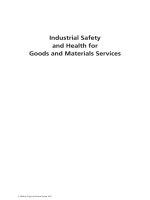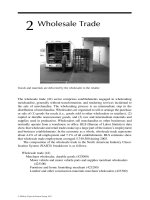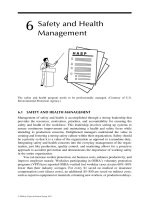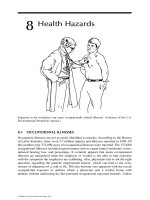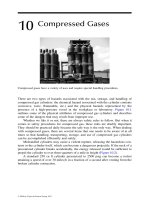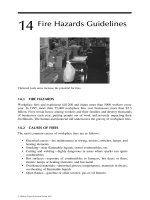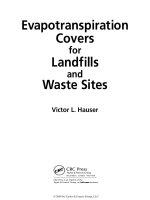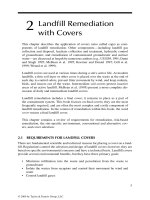Evapotranspiration covers for landfills and waste sites - Chapter 1 doc
Bạn đang xem bản rút gọn của tài liệu. Xem và tải ngay bản đầy đủ của tài liệu tại đây (807.45 KB, 19 trang )
CRC Press is an imprint of the
Taylor & Francis Group, an informa business
Boca Raton London New York
Evapotranspiration
Covers
for
Landfills
and
Waste Sites
Victor L. Hauser
© 2009 by Taylor & Francis Group, LLC
CRC Press
Taylor & Francis Group
6000 Broken Sound Parkway NW, Suite 300
Boca Raton, FL 33487-2742
© 2009 by Taylor & Francis Group, LLC
CRC Press is an imprint of Taylor & Francis Group, an Informa business
No claim to original U.S. Government works
Printed in the United States of America on acid-free paper
10 9 8 7 6 5 4 3 2 1
International Standard Book Number-13: 978-1-4200-8651-5 (Hardcover)
This book contains information obtained from authentic and highly regarded sources. Reasonable
efforts have been made to publish reliable data and information, but the author and publisher can-
not assume responsibility for the validity of all materials or the consequences of their use. The
authors and publishers have attempted to trace the copyright holders of all material reproduced
in this publication and apologize to copyright holders if permission to publish in this form has not
been obtained. If any copyright material has not been acknowledged please write and let us know so
we may rectify in any future reprint.
Except as permitted under U.S. Copyright Law, no part of this book may be reprinted, reproduced,
transmitted, or utilized in any form by any electronic, mechanical, or other means, now known or
hereafter invented, including photocopying, microfilming, and recording, or in any information
storage or retrieval system, without written permission from the publishers.
For permission to photocopy or use material electronically from this work, please access www.copy-
right.com ( or contact the Copyright Clearance Center, Inc. (CCC), 222
Rosewood Drive, Danvers, MA 01923, 978-750-8400. CCC is a not-for-profit organization that pro-
vides licenses and registration for a variety of users. For organizations that have been granted a
photocopy license by the CCC, a separate system of payment has been arranged.
Trademark Notice: Product or corporate names may be trademarks or registered trademarks, and
are used only for identification and explanation without intent to infringe.
Visit the Taylor & Francis Web site at
and the CRC Press Web site at
© 2009 by Taylor & Francis Group, LLC
v
Contents
Preface xv
Acknowledgments xvii
The Author xix
Chapter 1 Introduction 1
1.1 Waste Disposal 1
1.2 Waste Containment 1
1.3 Covers for Landll Containment 2
1.4 Laws and Regulations 3
1.4.1 Innovative Technology 3
1.4.2 The Current Situation 4
1.5 Purpose 4
References 4
Chapter 2 Landll Remediation with Covers 7
2.1 Requirements for Landll Covers 7
2.2 Risk-Based/Performance-Based Remediation 8
2.3 Factors That Inuence Remediation 9
2.3.1 Climate 9
2.3.2 Landll and Waste Characteristics 10
2.3.3 Hydrogeology 10
2.3.4 Gas Production 11
2.3.5 Soils and Plants 11
2.3.6 Seismic Environment 11
2.3.7 Reuse of Landll Areas 12
2.4 Cover Selection 12
References 13
Chapter 3 Conventional and Alternative Covers 15
3.1 Conventional Landll Covers 15
3.1.1 RCRA Subtitle C, Barrier Cover 15
3.1.1.1 The Cover Soil Layer 15
3.1.1.2
The Drainage Layer 16
3.1.1.3 The Barrier Layer 16
3.1.1.4 The Gas Collection Layer 17
3.1.1.5 The Foundation Layer 17
3.1.2 RCRA Subtitle D, Barrier Cover 17
© 2009 by Taylor & Francis Group, LLC
vi Evapotranspiration Covers for Landfills and Waste Sites
3.2 Alternative Barriers for Covers 18
3.2.1 Capillary Barrier 18
3.2.1.1 Capillary Barriers without Vegetation 19
3.2.1.2 Dry Barrier 19
3.2.2 Asphalt Barrier 19
3.3 Alternative Covers 20
3.3.1 The MSR Cover 20
3.3.2 Vegetative Covers 20
3.3.3 Inltrate–Stabilize–Evapotranspire Cover 21
3.4 Performance of Barrier Covers 21
3.4.1 Compacted Soil 21
3.4.2 Compacted Clay 23
3.4.3 “US EPA” Barrier Cover with Bare Soil Surface 24
3.4.4 Geomembrane Barriers 25
3.4.5 Composite Barriers 25
3.5 Performance of Alternative Covers 26
3.5.1 Capillary-Barrier Covers 26
3.5.1.1 Vegetated Surface 26
3.5.1.2 Bare Soil Surface 28
3.5.2 Vegetated Covers 28
3.5.2.1 The MSR Cover 28
3.5.2.2 Vegetation-Only Landll Covers 30
3.5.3 Asphalt Replaced by Vegetated Cover 30
3.5.4 ISE Cover 31
3.5.5 Common Elements of Vegetated Cover Failure 31
3.6 Focus of This Book 31
References 32
Chapter 4 Evapotranspiration Landll Covers 35
4.1 Denition 35
4.1.1 Minimum Requirements and Function 35
4.1.2 Soil Water Storage and Plant Roots 36
4.2 Differences 37
4.3 Concept Background and Proof 37
4.3.1 Water Balance by Soil Water Measurements 37
4.3.2 Experimental Proof 38
4.3.2.1 Short-Term Experiments 39
4.3.2.2 Wet Climate and Modied Soil 39
4.3.3 Long-Term Proof 39
4.3.3.1 Great Plains Water Balance 40
4.3.3.2 Pawnee National Grasslands 40
4.3.3.3 Saline Seep Region 41
4.3.3.4 Texas High Plains 42
4.4 Recovery from Fire 45
© 2009 by Taylor & Francis Group, LLC
Contents vii
4.5 Cost Comparison 46
4.6 Advantages and Disadvantages 46
4.6.1 Advantages 46
4.6.2 Disadvantages 47
4.7 Concept Use 47
References 48
Chapter 5 Basic Technology 51
5.1 Soil 51
5.1.1 Soil Physical Properties 51
5.1.1.1 Solids 52
5.1.1.2 Liquid 53
5.1.1.3 Air 54
5.1.2 Soil Water 54
5.1.2.1 Soil Water-Holding Capacity 55
5.1.2.2 Soil Water Pressure 55
5.1.3 Hydraulic Conductivity of Soil 58
5.1.4 Soil Water Movement 59
5.1.4.1 Water Movement to Plant Roots 60
5.1.4.2 Preferential Flow 61
5.1.5 Soil Chemical Properties 62
5.1.5.1 Soil pH 62
5.1.5.2 Soil Nutrients 63
5.1.5.3 Cation Exchange Capacity 63
5.1.5.4 Soil Humus 65
5.1.5.5 Harmful Soil Constituents 66
5.1.6 Soil Properties and Root Growth 66
5.1.6.1 Soil Tilth and Other Factors 66
5.1.6.2 Soil Strength and Density 67
5.1.6.3 Soil Density 67
5.1.7 Soil Modication 68
5.1.7.1 Natural Changes of Physical Properties 69
5.1.7.2 Chemical and Physical Modication 69
5.2 Plants 70
5.2.1 Plant Selection 70
5.2.2 Sod and Bunch Grasses 71
5.2.3 Trees and Shrubs 72
5.2.4 Selecting Native Plant Species 73
5.3 Plant Roots 74
5.3.1 Root Distribution within the Soil 75
5.3.2 Root Growth Rate and Maximum Depth 76
5.4 Other Technology 78
5.4.1 Soil Temperature 78
5.4.2 Salinity of the Soil Solution 78
© 2009 by Taylor & Francis Group, LLC
viii Evapotranspiration Covers for Landfills and Waste Sites
5.4.3 Soil Oxygen 78
5.4.4 Air-Filled Porosity 78
5.4.5 Chemical Toxicity 79
5.4.6 Allelopathic Toxicants 79
References 79
Chapter 6 Climate, Weather, and Water Balance 83
6.1 Climate and Weather 83
6.1.1 Climate 83
6.1.2 Weather 84
6.1.3 Precipitation Measurement 85
6.1.3.1 Accuracy of Precipitation Measurements 85
6.1.3.2 Standard Rainfall Measurement 86
6.2 Hydrologic Water Balance 86
6.2.1 Actual and Potential Evapotranspiration 87
6.2.2 Surface Runoff 88
6.2.3 Lateral Flow and Change in Soil Water Storage 88
6.2.4 Deep Percolation 88
6.3 Measuring Hydrologic Water Balance 89
References 90
Chapter 7 Potential Application 93
7.1 Limited Percolation 93
7.1.1 Evapotranspiration 93
7.1.2 Calculations 94
7.1.3 PET-to-Precipitation Ratio 95
7.1.4 Water Stress Days per Year 96
7.2 Increased Percolation for Waste Stabilization 97
7.3 Appropriate Use 97
References 98
Chapter 8 ET Landll Cover Design Steps 99
8.1 Site Characterization 99
8.2 Performance Criteria 100
8.2.1 Cover Requirements 101
8.2.2 Allowable Leakage through Covers 102
8.2.3 A Leakage Criterion 103
8.3 Cover Type 103
8.4 Preliminary Design 104
8.4.1 Design Model 104
8.4.2 Cover Soil Properties 104
8.4.3 Plant Cover 105
© 2009 by Taylor & Francis Group, LLC
Contents ix
8.4.4 Preliminary Cover Thickness 105
8.4.4.1 Sensitivity Analysis and Calibration 105
8.4.4.2 Thickness Estimate 106
8.5 Site-Specic Design 108
8.5.1 Weather 108
8.5.2 Soils 108
8.5.3 Plants 109
8.5.4 Integration and Interaction 110
8.6 Final Design 110
8.6.1 Layered Soil Covers 110
References 111
Chapter 9 Models for Design and Evaluation 113
9.1 A Model Philosophy 113
9.2 Requirements for ET Landll Cover Models 113
9.2.1 Water Balance 114
9.2.2 Actual ET 114
9.2.3 Models and Calibration 115
9.2.4 Design Model Requirements 115
9.3 Potential Model Accuracy 116
9.4 Modeling Soil Water Movement 117
9.4.1 Richards’ Equation 117
9.4.2 Water Storage Routing 118
9.5 Previous Model Evaluations 118
9.6 Evaluation of Three Models 119
9.6.1 HELP Model 119
9.6.2 EPIC Model 120
9.6.3 HYDRUS-1D Model 120
9.6.4 Model Differences 121
9.7 Model Test Data 122
9.7.1 Coshocton Data 122
9.7.2 Bushland Data 122
9.8 Comparison of Three Models 123
9.8.1 Data Evaluation 123
9.8.2 ET Estimates 124
9.8.3 Q Estimates 124
9.8.4 PRK Estimates 124
9.8.5 Monthly Estimates 127
9.9 Model Choice 128
9.9.1 HELP Model 128
9.9.2 HYDRUS-1D Model 128
9.9.3 EPIC Model 129
9.9.4 Model Conclusion 129
References 129
© 2009 by Taylor & Francis Group, LLC
x Evapotranspiration Covers for Landfills and Waste Sites
Chapter 10 Design Components 133
10.1 Weather 133
10.1.1 Precipitation 133
10.1.2 Solar Radiation 133
10.1.3 Length of Weather Record 134
10.1.4 Weather Record Uncertainty 134
10.1.5 Future Weather 135
10.2 Soil 136
10.2.1 Natural Soils 136
10.2.2 Soil Descriptions 137
10.2.3 Soil Design Data 137
10.2.3.1 Preliminary Soil Data 138
10.2.3.2 Final Soil Data 140
10.3 Plant Properties 140
10.4 Interaction of Plants, Soil, and Climate 140
10.5 Critical Design Event 141
10.6 Layered ET Cover Soils 143
10.7 Soil Erosion 144
10.7.1 Water Erosion 146
10.7.2 Wind Erosion 146
10.7.3 Erosion at Arid Sites 146
10.7.4 Soil Erosion Comparisons 147
10.7.5 Erosion Control Structures 148
10.8 Landll Settlement 149
10.9 Landll Cover Slope 151
10.10 Safety Factor for Minimum Percolation 151
10.10.1 Soil Thickness Basis 152
10.10.2 Hydrologic Basis 153
References 153
Chapter 11 Construction 155
11.1 Soil 155
11.1.1 Soil pH 155
11.1.2 Soil Humus Content 155
11.1.3 Harmful Constituents in Soil 156
11.1.3.1 Soil Salt 156
11.1.3.2 Sodium 157
11.1.4 Soil Physical Properties 158
11.2 Soil Density and Strength 158
11.2.1 Causes of Soil Compaction 159
11.2.2 Soil Water Content 159
11.2.3 Field Estimate of Plastic Limit 159
11.2.4 Vehicle or Machine Weight 160
11.2.5 Wheels and Tracks 160
© 2009 by Taylor & Francis Group, LLC
Contents xi
11.2.6 Measurement of Soil Density and the Cone Index 161
11.2.7 Field Operations and Remediation 161
11.3 Soil Placement 162
11.3.1 Machinery and Haul Roads 162
11.3.2 Remediation of Compaction 163
11.3.3 Test Covers 163
11.4 Interim Soil Erosion Control 163
11.5 Grass Establishment 165
11.5.1 Species 165
11.5.2 Fertilizer 165
11.5.3 Seeding Machines 165
11.5.4 Seeding Methods 166
11.5.4.1 Hydroseeding 166
11.5.4.2 Solid Sod Application and Sprigging 166
11.5.4.3 Broadcast Seeding 166
11.5.4.4 Drill Seeding in Bare Soil 167
11.5.4.5 Drill Seeding Mulch Cover 167
11.6 Drill Seeding in Standing Crop Residue 167
11.6.1 Benets 167
11.6.2 Mulch Crop 167
11.7 Irrigation 168
11.8 New Grass Establishment Methods 168
11.9 Construction Completion 169
References 169
Chapter 12 Maintenance and Monitoring 173
12.1 Deep Percolation Monitoring 173
12.2 Cover Integrity 174
12.3 Groundwater Monitoring 174
12.4 Vegetation Management 174
12.5 Burning 175
12.6 Grazing 175
12.7 Weed Control 175
12.8 Soil Fertility and Chemistry 176
12.9 Soil Density Control 176
References 177
Chapter 13 Miscellany and Summary 179
13.1 Design and Prescriptive Rules 179
13.2 Allowable Leakage 179
13.3 Technical Resources 180
13.4 Research Needs 180
13.5 Summary 181
© 2009 by Taylor & Francis Group, LLC
xii Evapotranspiration Covers for Landfills and Waste Sites
Appendices 183
Index 191
© 2009 by Taylor & Francis Group, LLC
This book is dedicated to Bettye
© 2009 by Taylor & Francis Group, LLC
xv
Preface
We generate a large and ever-increasing volume of waste. The waste originates from
rural and urban areas, industrial operations, mining, and other activities. In spite of
efforts to reuse wastes, a large part of it is deposited in landlls, mineland dumps, etc.
Direct contact with the waste or the potential harmful effects of gasses and liq-
uids generated within the waste may pose a threat to humans and the environment.
The current method of choice for controlling harmful effects of these wastes is con-
tainment in landlls and similar structures. Containment is costly; it is relatively, but
not perfectly, effective. Some waste may pose a threat to humans and the environ-
ment for millennia, thus making containment difcult.
This book does not contain arguments regarding the merits or demerits of waste
containment; it does present a better way to build the part of the containment system
that we call the landll cover for municipal and industrial landlls. The principles
governing the new cover are the same when used on other wastes.
The evapotranspiration (ET) cover is a better way to cover wastes at many sites.
The ET cover employs two simple elements: (1) a layer of soil and (2) plants growing
on the surface. The concept is ancient; however, its application to landll covers is
new. Most of us seldom think about the role of soil and plants in making life possible
on our planet. The principles have worked since the beginning of time; they govern
the production of the food supply for both humans and Earth’s other inhabitants.
This process forms the basis for the ET cover for landlls and waste.
The primary purpose of this book is to explain the innovative ET cover concept,
its verication, fundamental concepts, design, construction, and maintenance. To
accomplish these tasks, the book is organized into ve broad categories as follows:
Part I. Chapters 1 and 2 briey describe waste, and the role of covers in con-
tainment. Chapter 3 describes conventional and some alternative landll covers. An
important part of Chapter 3 is the analyses of performance of conventional covers as
measured by several investigators. These measurements are the basis for an assess-
ment of allowable landll cover leakage in Chapter 8.
Part II. Chapter 4 describes the ET cover concept and its proof. New ideas usu-
ally require new research; the ET cover is an exception because the proof is already
available. It remains for us to gather the recorded proof and apply the concept.
Part III. Chapters 5 and 6 contain fundamental technology required to apply the
ET cover. Chapter 7 discusses potential application of the ET cover.
Part IV. Chapter 8 discusses design steps, and Chapter 10 contains in-depth appli-
cation of fundamental technology to selected design components. Chapter 9 presents
an in-depth discussion of models for cover design and their potential accuracy; it
evaluates the accuracy of three different models against eld measurements.
Part V. Chapter 11 presents construction requirements that are unique to ET cov-
ers. Chapter 12 discusses maintenance and monitoring issues pertinent to ET covers,
and Chapter 13 contains summary information.
Several available reference books and papers are noted in the book to assist the reader
in nding additional information needed for design to meet unusual conditions.
© 2009 by Taylor & Francis Group, LLC
xvii
Acknowledgments
Because the technology required for ET covers includes a large number of different
scientic and engineering disciplines, I am indebted to many individuals.
Two research scientist colleagues at the Agricultural Research Service of the
USDA deserve special mention: they are Dr. Howard M. Taylor, soil physicist, who
introduced me to the eld of plant root growth and the effect of soil strength on plant
production and Dr. F. W. (Wes) Chichester, who taught me about plant nutrition and
soil modication.
The reviewers of this book—Dr. J. R. Williams, Texas Agricultural Experi-
ment Station; Dr. Peter J. (Pete) Shouse, The US Salinity Laboratory, Agricultural
Research Service of the USDA; and anonymous reviewers—provided useful and
valuable evaluations. Their comments were very useful and improved the book.
© 2009 by Taylor & Francis Group, LLC
xix
The Author
Dr. Victor L. Hauser, P.E., is an agricultural engineer; he has B.S., M.S., and Ph.D.
degrees from Oklahoma State University, the University of California at Davis, and
Texas A&M University. He was a research engineer for the USDA, Agricultural
Research Service, responsible for research projects in the Great Plains of the United
States. His research included water management and crop production, hydrology,
soil modication to improve plant production, mineland reclamation; grass estab-
lishment, soil erosion control, irrigation, hydrogeology, groundwater recharge, and
water quality. He collaborated with engineers and scientists from the Great Plains
states on successful water conservation research and with Dr. M. Rebhun, Israel
Institute of Technology, to develop innovative and successful water clarication sys-
tems for groundwater recharge.
As research leader for the Agricultural Research Service, he participated in
research planning and publication of results on hydrology, water management, range-
land management, soil modication, entomology, ecology of rangelands, ood con-
trol, and irrigation. His research covered the southern half of the Great Plains states.
As principal engineer for Mitretek Systems, Dr. Hauser provided technical
review of remediation activities for groundwater, landlls, fuel spill sites, and simi-
lar site remediation activities for the U.S. Air Force, Navy, and Army. He developed
technical publications on landll covers, phytoremediation, and other topics for the
U.S. Air Force.
Dr. Hauser is an active member of the American Society of Agricultural and
Biological Engineers, the American Society of Civil Engineers, the American Soci-
ety of Agronomy, the Soil Science Society of America, and Sigma Xi. He is a Fellow
of the American Society of Agricultural and Biological Engineers and a registered
professional engineer in Texas. He has authored 84 technical papers and 60 reports,
technical publications, and other papers.
© 2009 by Taylor & Francis Group, LLC
1
1
Introduction
The people of the modern world produce a large volume of waste products
including municipal garbage and waste, mining, industrial, and atomic waste.
Other materials including fuel, solvents, industrial chemicals, etc., become
waste when discharged onto the land. These materials typically have low value,
which leads to their classication as waste; however, they have the potential to
contaminate the environment. The waste volume, and thus the area covered by
them, is typically large.
Because of the fear of possible harmful effects that may result from these
wastes, costly resources are allocated to control the contamination threat.
Municipal and industrial wastes are commonly deposited in landlls. Min-
ing waste is typically discharged onto the land surface or, in the case of strip
mining, deposited in the hole left by excavation for ore. Atomic wastes, fuel,
and chemicals may be present in landlls and in soils and groundwater over
large areas.
1.1 Waste Disposal
Some municipal and industrial waste is burned, recycled, or composted. The high
cost and the low value of the product limit the volume of waste that is recycled or com-
posted. Waste burning signicantly reduces its volume and consumes many waste
products. However, public fear of air pollution limits the opportunity to burn waste.
The volume of waste produced is large, and movement and treatment are expensive;
as a result, most of it is disposed in a nearby landll for long-term storage.
The goal for currently used remediation technology is waste containment to pro-
tect the environment and public health. This philosophy produced a system that, in
effect, preserves low-value waste for an indenite time.
Innovative methods are under development to remediate large volumes of waste.
For example, the bioreactor landll controls contaminants and at the same time rap-
idly degrades waste into harmless products. The bioreactor landll quickly reduces
both the threat from the waste and the waste volume. A bioreactor landll is reusable
for waste disposal; it is under development and coming into use at this time (Rein-
hart and Townsend 1998; US EPA 2002; ITRC 2006).
1.2 Waste Containment
Currently, the accepted treatment for the large volumes of low-value waste depos-
ited in either conventional or innovative landlls is “containment” rather than
© 2009 by Taylor & Francis Group, LLC
2 Evapotranspiration Covers for Landfills and Waste Sites
remediation. Government rules and regulations rely on the containment philoso-
phy. The purpose of containment is to prevent movement of the waste and control
groundwater contamination by leachate from the waste. Containment may include
a bottom liner under the waste, gas control, and other features. Almost all contain-
ment systems employ a cover to (a) minimize movement of precipitation through the
waste, (b) isolate the waste, and (c) control gases if produced by the waste.
A consequence of the containment philosophy is preservation of low-value waste
and its decay products for decades or centuries. The concept of waste preservation by
containment imposes signicant requirements on components of the containment sys-
tem. In order to provide containment at reasonable cost, and for long time periods—
possibly centuries—the parts of the system should be self-renewing and durable.
Figure 1.1 illustrates three types of waste containment and the use of covers for
each: (a) a modern landll with a bottom liner; (b) older landlls, mineland, and
other waste with no bottom liner; and (c) a cover for soil contaminated by a chemical
spill, leak, or other discharge. Landlls with bottom liners typically include leachate
collection and gas control structures; any of them may need gas control. The cover
may be the most costly feature of containment for the waste sites illustrated, and is
usually the only containment structure for those such as (b) and (c).
This book focuses on waste containment by landlls and, in particular, on their
cover requirements. The principles of cover design are similar for other waste sites
as well.
1.3 Covers for lanDfill Containment
The application of the containment remedy usually requires the design and instal-
lation of a landll surface cover. Other components, such as gas collection and
disposal, groundwater treatment and containment, and the collection and disposal
of leachate, may also be required. The cover, whether conventional or innovative,
should work in harmony with other parts of the containment system.
Cover
Waste
(a)
Bottom liner
Cover
Waste
(b)
Cover
Contaminated Soil
(c)
Fill
figure 1.1 Three types of waste containment by covers.
© 2009 by Taylor & Francis Group, LLC
Introduction 3
Because the intention is to contain the waste for decades or centuries, the cover
should be self-renewing and durable. Reconstruction of a cover in the future will be
expensive and creates the risk that contaminants may escape the containment system
during construction activities. All components of a containment system in the United
States are subject to rules and regulations by the U.S. government and the states.
1.4 laWs anD regulations
The federal regulations governing hazardous and municipal landlls in the United
States are found in the Code of Federal Regulations (CFR)—for example, 40 CFR 264
for hazardous waste and 40 CFR 258 for municipal solid waste. State statutes usually
apply when they are equal to or more protective than the published federal regulations.
In the United States, the Resource Conservation and Recovery Act (RCRA) is
the controlling federal law for both municipal solid waste and hazardous waste land-
lls. RCRA enforcement authority is delegated to the states; they are required to
have equal or more protective regulations than those contained in federal rules and
regulations. RCRA contains many specic requirements regarding the construction,
operation, and closure of a landll, including surface water requirements; ground-
water contamination and monitoring; closure system assessment and monitoring;
closure criteria; and postclosure care requirements. The remediation of old landlls
is generally addressed under the Comprehensive Environmental Response, Com-
pensation, and Liability Act (CERCLA) with RCRA considered as an Applicable
or Relevant and Appropriate Requirement (ARAR). Even though the federal rules
and regulations contain specic design requirements, they also allow exibility and
use of innovative designs that are protective of public health and the environment.
Koerner and Daniel (1997), US EPA (1991), Weand et al. (1999), and ITRC (2003)
discuss federal rules and regulations.
1.4.1 In n o v a t I v e te c h n o l o g y
Federal regulations for landlls are uniquely different from those for other remedia-
tion efforts. They contain design requirements for landll cover elements; however,
regulations for other remediation efforts do not contain design requirements. In the
past, both federal and state regulators insisted upon strict application of these landll
cover design requirements, thus allowing little or no latitude for design and construc-
tion innovation.
However, there is long-standing law and policy that supports landll cover innova-
tion and allows designs that are different from the requirements stated in the rules and
regulations (Weand et al. 1999). Congress acknowledged the need for innovation in the
Superfund Amendments and Reauthorization Act of 1986 (Public Law 96-510 known
as SARA): “The Administrator is authorized and directed to carry out a program of
research, evaluation, testing, development, and demonstration of alternative or inno-
vative treatment technologies … which may be utilized in response actions to achieve
more permanent protection of human health and welfare and the environment.”
EPA’s Ofce of Solid Waste and Emergency Response (OSWER) Policy Direc-
tive 9380.0-25 denes EPA’s support of innovative technologies, and it expresses
© 2009 by Taylor & Francis Group, LLC
4 Evapotranspiration Covers for Landfills and Waste Sites
EPA’s frustration with the difculty of getting innovative technologies approved and
implemented in the eld (US EPA 1996). Overall, this is a critical directive because
it states EPA’s explicit support for innovative technologies. The directive gives help-
ful information to the remedial project manager (RPM) on how to build a consensus
for innovative technology at a particular site.
The EPA and the Environmental Council of the States jointly prepared an agree-
ment to pursue regulatory innovation (US EPA 1998). The agreement encourages
and facilitates the exploration of ideas that are potentially more cost-effective or
have a better environmental impact. This agreement powerfully reinforces the com-
mitment by the EPA and the states to nd innovative regulatory solutions and to
avoid being constrained by outdated or overly restrictive regulations. The agreement
emphasized that regulatory innovation activity should start with the states because
the states are generally delegated RCRA authority and they need to support and
pursue regulatory relief.
1.4.2 th e cu r r e n t SI t u a t I o n
The technology used in the landll cover portion of landll remediation is chang-
ing, and alternative covers are coming into use (ITRC 2003; US EPA 2003). The
states are actively supporting innovation as demonstrated by the ITRC’s technical
and regulatory guidance for design, installation, and monitoring of alternative nal
landll covers (ITRC 2003). Accordingly, the application of rules and regulations is
changing, thus creating the need for design, construction, and maintenance technol-
ogy for alternative nal landll cover.
1.5 purpose
Evapotranspiration (ET) is the sum of evaporation of water from the soil surface and
plant transpiration. This book explains an innovative landll cover that relies on ET
and other natural forces to provide the benets required of a landll cover. The book
includes the ET cover concept, its verication, design, construction, maintenance,
and allowable leakage through landll covers.
Although this book deals with landll covers, the ET cover concept applies
equally well to other waste disposal facilities, lagoons, spill sites, spoil piles, mine-
land restoration, or other facilities needing a nal cover. It is well suited to use on
bioreactor landlls because it is easy to build it to provide the added water needed
to speed the waste decay process. The principles are similar in each case to that
described here for landlls.
referenCes
Koerner, R. M. and Daniel, D. E. (1997). Final Covers for Solid Waste Landlls and Aban-
doned Dumps. ASCE Press, American Society of Civil Engineers, Reston, VA.
ITRC (2003). Technical and regulatory guidance for design, installation, and monitoring
of alternative nal landll covers. Interstate Technology and Regulatory Council,
444 Capitol St., NW, Suite 445, Washington, DC 02001. />homepage.asp (accessed March 14, 2008).
© 2009 by Taylor & Francis Group, LLC
Introduction 5
ITRC (2006). Characterization, design, construction, and monitoring of bioreactor landlls.
Interstate Technology andRegulatory Council, 444 Capitol St., NW, Suite 445, Wash-
ington, DC 02001. (accessed March 14, 2008).
Reinhart, D. R. and Townsend, T. B. (1998). Landll Bioreactor Design and Operation.
Lewis Publishers, Boca Raton, FL.
US EPA (1991). Design and Construction of RCRA/CERCLA Final Covers. EPA/625/4-
91/025, Ofce of Research and Development, US EPA, Washington, DC.
US EPA (1996). Promotion of Innovative Technologies in Waste Management Program. EPA
OSWER Policy Directive 9380.0-25, Ofce of Solid Waste and Emergency Response,
US EPA, Washington, DC.
US EPA (1998). Joint EPA/State Agreement to Pursue Regulatory Innovation. Ofce of
Reinvention, Federal Register, May 5, 1998, pp. 24784–24796.
US EPA (2002). State of the Practice for Bioreactor Landlls. EPA/625/R-01/012, National
Risk Management Laboratory, US EPA, Cincinnati, OH.
US EPA (2003). Evapotranspiration Landll Cover Systems Fact Sheet. EPA 542-F-03-015,
Ofce of Solid Waste and Emergency Response, Cincinnati, OH.
Weand, B. L., Horin, J. D., Hauser, V. L. et al. (1999). Landll covers for use at Air Force
installations. The Air Force Center for Environmental Excellence (AFCEE), Brooks
City Base, San Antonio, TX. />landllcovers/LandllProtocols.asp (accessed March 14, 2008).
© 2009 by Taylor & Francis Group, LLC

